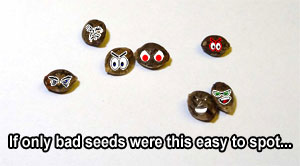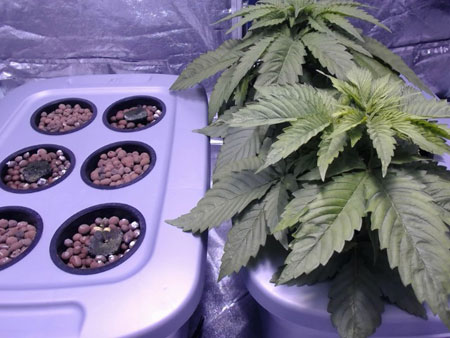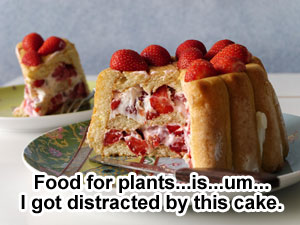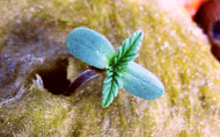You are hereWhy the First Few Grows Can Seem So Tough...
Why the First Few Grows Can Seem So Tough...
by Sirius Fourside
I’m not ashamed to admit that my first few grows ended in complete and utter failure. I had some bad information, and I combined that bad information with some over-priced products and a dash of over-zealousness. Each of those times, I ended up with plants that never got the chance to make even tiny buds I could actually harvest!
With some time and practice, I can now grow more better-than-medical-dispensary bud than I can use while expending a minimal amount of effort. But I’m not special!
I’m no artist, prodigy, phenom or anything even remotely close to those things! I just learned to fix a few mistakes that were holding me back as a grower, and today I’m going to go through some of those common setbacks and make sure they don’t…well, set you back!
Too Much Love
 Is it possible to love something too much? I’d say Nebula might love cats too much. A baker once told me I love desserts too much (he was right). And we’ve all known at least one overprotective mom who loved her child too much. Loving something too much isn’t really a problem, it’s the extraneous attention we give as a result of that love.
Is it possible to love something too much? I’d say Nebula might love cats too much. A baker once told me I love desserts too much (he was right). And we’ve all known at least one overprotective mom who loved her child too much. Loving something too much isn’t really a problem, it’s the extraneous attention we give as a result of that love.
When it comes to growing cannabis, that extra love can mean that growers check on their plants more often than needed. While there’s nothing wrong with checking on your plants often, these extraneous check-ins often mean the growers is going to do something to the plants. A poke here, a trim there, maybe a little water…
The fact is, plants spend a lot of time not doing much. Or rather, they spend a lot of time doing things very slowly. This means that there will be long periods (sometimes days) where there isn’t much (if anything) for the grower to do.
Unfortunately, there isn’t a trick to beating the waiting game. Just treat these times like the perfect opportunity to practice patience, because the flowering stage requires a lot much of it!
Is My Plant Really Thirsty?
The best instructions are the kind that are specific. Well made, specific instructions can teach a totally untrained person to do a specialized and/or complicated task. The bane of good instructions is telling the user to make a judgement call. If they’re untrained, their judgement call might just be a wild guess!
Unfortunately, plant watering requires many judgement calls. How often do I water? How much do I water? Am I watering too much?
It would be nice to be able to tell growers, “Give your plants exacts .5 gallons of water every Monday and Thursday until harvest”. But there are too many variables (strain, pot size, plant size, temperature, humidity, etc.) to be able to make such a statement. Luckily, watering is a breeze after a couple of attempts, and here are some guidelines to make it even easier.
- Make sure your pot/container has proper drainage. This means excess water should be able to freely escape the bottom of the pot.
- Wait to water your plants until the top inch of your medium feels dry.
- When watering, make sure that 20% of the water comes out the bottom of your container. This helps prevent pH problems amongst other things.
Great instructions on watering: http://www.growweedeasy.com/how-often-water-marijuana
Playing The Light Game
There are plenty of ways to deliver light to your plant. Some are lucky enough get their light straight from the biggest light for Earth: the Sun.
Us indoor growers have to navigate the hotly debated and often confusing world of indoor grow lights. Every side claims to be the best for one reason or another: CFL users say their bulb is stealthy and low cost, LED lovers say their lights are the future, and those in the HPS camp say no light will take their crown! And that’s not even mentioning the others like T5s, CEDs etc.
The fact is, most types of grow lights will work great under the right circumstances. If you’re somewhat new to growing indoors and are having a hard time deciding on a type of grow light, here’s what I would recommend:
- Small stealthy grows, PC grows, file cabinet grows, or just trying to get a feel for the process
- Growing in a small (< 4’ x 2’) tent, closet or something similar
- Larger (>4’ x 4’) tent, walk-in closet or something similar
- Huge areas like grow rooms that encompass the entire room
- Multiple 1000w HPS lights are the standard for big indoor grow operations
- The sun; it can't be beat for the price!
Read more about grow lights: http://www.growweedeasy.com/grow-lights
Bad seeds = Confidence Killer
 Growing with bad seeds is particularly harsh on growers of all levels. This is mostly because it’s tough to pinpoint when the seed itself is the actual problem. Most growers will blame themselves for a problem that shows up in their grow long before they assume it’s the seeds.
Growing with bad seeds is particularly harsh on growers of all levels. This is mostly because it’s tough to pinpoint when the seed itself is the actual problem. Most growers will blame themselves for a problem that shows up in their grow long before they assume it’s the seeds.
The term ‘bad seeds’ refers to any type of seed that has a significantly higher likelihood of causing problems in a grow. Most notably, this includes:
- Bagseed
- Bagseed you randomly find in your buds wasn’t supposed to be there, so that means that its genetics are a toss-up. Even if it started with good parents, there’s no telling how high or (more likely) low the quality will be. Unfortunately, the only way to find out is to grow it… Some growers win the genetic lottery, but many others lose out.
- Beat-up seeds
- These are seeds you might get from a friend, or maybe you have them stashed somewhere and forgot how you got them. In either case, if the shell of the seed looks beat-up, you probably don’t want to risk wasting your time on it.
- Old seeds
- Seeds are a little nugget of genetic material than can hopefully grow into a plant. And like all other genetic material, it doesn’t last forever! Although seeds can be viable for quite a few years after they’re made, the chances of them successfully germinating goes down with time. Check out the picture below. We planted all the plants at the same time. The tub on the right has seeds that were planted within a week of receiving them in the mail. The tub on the left has a very popular strain with award-winning genetics...but the seeds were also 6 years old. The seeds on the left got outpaced by algae!
Don't deal with bad seeds: http://www.growweedeasy.com/seeds
Plant Food Should Be Easy, Right?
Cannabis nutrients is the one of those niches within the cannabis industry with hundreds and hundreds of companies vying for your money. Why?
In my opinion, there are two main reasons:
- Nutrients don’t cost much to make, but they tend to sell for higher prices.
- Cannabis plants have simple requirements, so it isn’t difficult to make nutrients that satisfy those requirements.
In short, this means that even a no-name company with little-to-no experience can make nutrients that work as well as high-priced nutrients. This lower barrier of entry combined with high profits makes for a lot of competing companies who all essentially do the same thing. Unfortunately for newer growers, it means they have to wade through a bunch of products to find something that does the job.
If you’re in this spot, allow me to narrow down your choices to the proven companies that won’t overcharge you:
- General Hydroponics - Their "Flora Trio" is dirt cheap and works amazing! Soon to be a household name as they’ve been purchased by a company related to Miracle-Gro who wants to bring the trio to stores like Wal-Mart (it’s actually a good thing)!
- Fox Farms - High quality nutrients with a solid reputation for quality. They also make great soil.
- Dyna-Gro - Possibly the cheapest nutrient system to get started with, and works like a charm!
More information on cannabis nutrients: http://www.growweedeasy.com/nutrients
Trying Advanced Techniques Too Soon
There are some growing techniques that growers can try right out on their first grow if they’re feeling adventurous enough. There are simple plant training techniques (such as FIM’ing and low-stress training) are easy, have low time requirements and are low risk. This means that even brand new growers can try them out without much consequence if it doesn’t go perfectly.
On the other hand, there are techniques like Manifolding, ScrOG and defoliation. These techniques can be tough to do, they carry a higher risk for your plants, and they can add days or weeks to your total grow time without offering any benefits if done the wrong way.
Although we feel that each of these techniques can pay for itself in the right conditions, they should only be employed when the grower knows those conditions and the technique doesn’t become a burden on them.
For example, a grower could start a ScrOG setup and end up having to spend additional hours (yes, plural) each week making sure the ScrOG net is being utilized correctly. Meanwhile, a grower could be using a much more simple setup to grow much more bud than he or she can use.
In short, keep it simple until you know you’re ready for something more advanced.
Getting Set Up
Getting setup is basically a larger version of the problem new growers face when buying lights. There is a lot of money to be made in selling growing equipment, especially since cannabis cultivation isn’t fully mainstream and the prices of said equipment are still inflated.
This (again) means that you have a way too many choices and way too many decisions to make when it comes to getting your equipment. Luckily, one of our greatest strengths as humans makes for a simple solution to this issue: our sociability!
If you’re thinking about buying a particular product, make sure to look into it before you buy. Reviews will give you insights into products that you normally have to purchase them to find out. I’ve also learned a great deal of valuable information from the people who work at my local hydroponic stores. In fact, my current setup is almost entirely comprised of suggestions from knowledgeable growers in my hydro stores. They saved me the time of trying out products that could have potentially disappointed me, and instead helped me get gear so good I can’t leave it behind!
Don't have anyone to ask in person? Learn what you need to start growing cannabis indoors
What were some mistakes you made (or are still making) as a new grower? What information would you impart on new growers to help save them some time and make their grows go better? Did I miss a big one? Let us know by replying to this email!
Jump to...
10-Step Quick Start to Growing Cannabis
Plant Training Techniques to Increase Yields
Where can I order seeds online?







